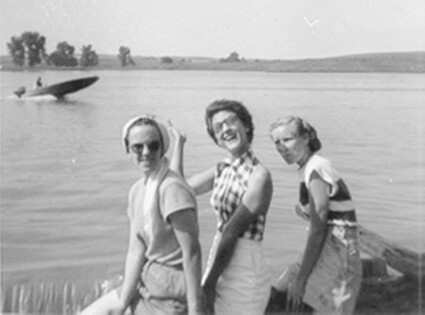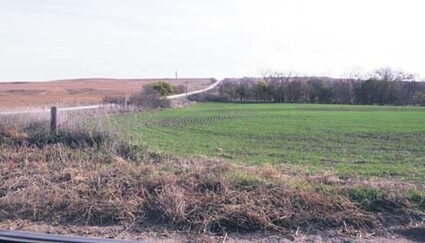Scarbrough Hill named after early Jewell City settler
March 23, 2023

Beth Burnham Chambers, Bette Kent Willmeth and Betty Collie James are sitting on the edge of the overflow-spillway of the Jewell County Pond. The view is looking to the north. The photo is from the collection of Linda Hutchcraft Woerner.
The story is told that Billy Street, in the early days of the settlement at Jewell, walked west and climbed Scarbrough Hill. To the north, south and west, a vast herd of buffalo was all he could see. The hill may or may not have been called "Scarbrough" when Street made his climb, but if not, it soon would be.
The big hill west of Jewell was named for early Jewell City settler, James A. Scarbrough. His mother, Sarah McGamey Scarbrough homesteaded on the southwestern slope of the hill. James, who came to Jewell County in 1870, built a home on the southern point of the hill in 1872. The house, with no roof, was a county landmark for years. (Jewell County Republican, Sept. 23, 1910) It was finally torn down in 1923, "the best-known landmark within a radius of 100 miles." (Jewell County Republican May 26, 1923)
James A. Scarbrough was born in Tennessee on March 9, 1837. He is found in the 1850 U.S. Census in Monroe County, Indiana, then in Mercer County, Missouri, in the 1860 U.S. Census. The 1870 U.S. Census finds him among the 204 enumerated in Jewell County.
Scarbrough and his family would be in the Jewell County area for most of the next 10 years. James Scarbrough married Mattie Slagle on Nov. 23, 1871 in Waterville, Kansas. They had one son who grew to adulthood.
There were many firsts in Scarbrough's life. On May 10, 1870, he was the first to break the prairie sod north of the forks of Buffalo Creek. He was the first to bring in a stock of goods to Jewell City. He opened the items in Fort Jewell on June 20, 1870. (Atchison Weekly Champion, July 8, 1871) On June 30, 1870, he was the first to construct a building in Jewell City. It was the first store in both the community and the county. (Jewell County Republican, July 2, 1880)
Scarbrough was the first Jewell County clerk. He was appointed by Governor James Harvey when the county was organized on July 14, 1870. In the first elections, Aug. 22, 1870, he became the first elected Jewell County clerk.
He was a business man, a real estate agent and at one time sold reapers in Jewell and Smith counties. (The Commonwealth, June 10, 1875) But he was most well-known for his connections with the newspaper business. He was a "boss" reporter (Jewell County Review, Aug. 21, 1879) and a "brilliant" writer. (Beloit Courier, May 20, 1880)
Known over the state as a newspaperman, he wrote, edited or worked for The Blade and Commonwealth newspapers in Topeka, the Beloit Courier, the Beloit Daily Call, the Beloit Weekly Courier, the Jewell County Diamond, the Jewell County Monitor, plus The Pioneer and the True Voter in Smith Center. At times he wrote for newspapers with the pen name "the Pioneer" and also worked as a traveling reporter with various politicians.
Though he was not the first postmaster of Jewell, he was the third and the fifth. It was the post office job which led to a drastic downfall. While running for the nomination for Kansas Secretary of State in 1874, he used some $1,500 dollars embezzled from the post office and express company to finance his campaign. (This would amount to approximately $39,000 today.)
Arrested in Pueblo, Colorado, he was jailed in October of 1874 in Missouri. Released on $500 bail in April of 1875, his trial was postponed. Though there are literally hundreds of newspaper items about Scarbrough from 1875 to 1880, this researcher has not found when, or if, a trial occurred.
During the five years from 1875 to 1880, Scarbrough was constantly busy with his newspaper career. Even after the embezzlement scandal, he was popular and well liked. But his finances were in disarray and his health declining.
In November of 1880, his health was in such a dire state, his friends in Smith Center raised $100 (more than $2,000 today) to send him to Eureka Springs, Arkansas, to seek a cure. He died on the way, in a hotel in Atchison, Kansas.
"Well known to every newspaper man of Kansas," his newspaper friends in Atchison rallied round. A coffin was purchased as well as the train fare back to Jewell County. The group did not keep the $100 found in his wallet but sent it back to the "destitute" widow. (Atchison Daily Patriot, Dec. 3, 1880) His mother, Sarah McGamey Scarbrough, buried him in Athens Cemetery.

Comments and newspaper items about James Scarbrough continue through the years but Scarbrough Hill first appears in the July 10,1885, Jewell County Republican. The item tells of a "stereoscopic view from the top of Scarbrough hill" taken by Dunham and Stidham photographers in Jewell. It showed the Kansas scenery "perfectly."
The view is again discussed in the July 23, 1897, Jewell County Republican. Travelers going west describe the Brown's Creek and Buffalo Creek valleys as "magnificent." Horace Salisbury is connected to Scarbrough Hill as he is credited with being the last homesteader in Jewell County. His 80 acres is "in the bluffs on the north side as you go over Scarbrough Hill." Nov. 2, 1898, Jewell County Republican.
A comment in the March 31, 1947 Jewell County Republican tells us something else about Scarbrough Hill. The comment calls an "Old Settler" one who remembers when the "road wound around Scarbrough Hill instead of over it." Today, nobody remembers the road going anywhere but straight over.
Joe Eilert, who now owns the pasture on the south side of the road, knows there is a "well used path" around the southwestern portion of the hill. Whether this path was part of the old road is not known. Eilert believes a road around the hill would have needed to go a half mile to the south because of a deep canyon on the southern side of the hill.
Things changed in 1901. The "farmers west of Jewell" were working to make a "passable road" over Scarbrough. Also "giant powder and dynamite" were received for the purpose of "blasting a out a roadway over Scarbrough Hill." This according to the May 24 and 31, 1901 Jewell County Republicans.
The first road was likely narrow. In 1908, the cut was being "deepened and widened so two hayracks can pass." This work was paid for with $100 each from Buffalo Township, Calvin Township and the Jewell City Commercial Club. J. E. Topliff was in charge of workforce of 15 men with scrapers and dynamite. ( Feb.6, 1908, Jewell County Republican)
But the work completed in January 1908 didn't keep the snow of February out of the cut.The Feb. 21, 1908, Jewell County Republican reported the cut was "level full of snow." It was drifted shut again in 1912 (March 1, 1912, Jewell County Republican). It was filled again with snow in 1915 and was still "four feet deep" when "10 Brown's Creekers" worked together to clear it out. (March 25, 1915, Jewell County Republican)
By April of 1915, it wasn't snow but mud that made the news. Scarbrough was "almost impassable" because of "deep mud." The question was asked why rock from the sides of the cut wasn't"pounded into the track." The question was not answered. (April 9, 1915, Jewell County Republican)
And again, more work on the road. In the Dec. 28, 1916, Esbon News, it was reported the Jewell County Commissioners were to get involved with the road over Scarbrough Hill. Their plan was to buy $50 of land on the south side of the road from C.R. Hewitt in order to widen the road.
But the road was still steep and hard for a team or a Model T to climb. Joe Eilert remembers his mother, the late Kathryn Gallagher Eilert, telling of hitching a second team to a wagon to get over the hill. At times someone would have a spare team there and it would be used in relays to get wagons over the hill.
Another story told by Kathryn was about their Model T. It would not go up the hill without the transmission slipping, unless they went over the hill in reverse. The Model T pulled better in reverse. The Gallagher family wasn't the only ones who backed over Scarbrough Hill.
Work on the road over the hill continued over the years. J. W. Hooker had a crew working on Scarbrough Hill in 1919 and the Jewell County Commissioners paid $46.68 for work done by Calvin Township in 1922. (Jewell County Republicans, May 23, 1919 and Jan. 20, 1922)
Work on the road in 1928 resulted in the comment "The new rock road over Scarbrough Hill can be seen from town." (Jan. 6, 1928, Jewell County Republican) Over the years, the road over Scarbrough Hill has been dirt (mud), rock, gravel and blacktop. Residents constantly trying to find the best way to go over "Old Scarbrough."
But another change was in the offing.
The Jewell County Commissioners voted to build a $3,500 "demonstration pond" on the west side of Scarbrough on the north side of the road. This project would "widen the road to 10 feet" and the road grade "would cause the hollow at the foot of Scarbrough to disappear." The pond would cover 15 acres, be very deep by the dam and be stocked with fish by the state. (Nov. 2, 1928, Jewell County Republican)
The construction of the pond began in November of 1928. The Nov.16, 1928, Jewell County Republican reported the dam would be 16 foot high and the pond about 20 feet deep by the dam.
The Jewell County Republican noted work on the pond-Scarbrough cut in the March 29, 1929, April 25, 1930, and several issues in the spring of 1933. The May 26, 1933, issue noted the dam was almost completed. The widening of the road and building the dam were Federal Reconstruction Finance Corporation projects. The rock from the road work was used as riprap on the dam project.
Joe Eilert remembers Clarence Topliff telling him about the construction work. If Topliff had time away from his farming, he would take his team of mules over and work hauling dirt. He would get paid for his time and didn't have to have a slip or equipment as it was provided.
The drought of the 1930s lowered the water level in the pond to such an extent that in August of 1937, Game Warden H. D. Byrne of Concordia and Fred Gray seined out about 1,500 fish. The fish were put into several area ponds. (12 Aug. 12, 1937 Jewell County Republican)
Rains came and the pond again filled. Pictures from the 1940s show motor boats on the pond. Stories are told of water skiing too. It is said that Steve McIntyre learned to waterski on the pond.
The July 6, 1944, Jewell County Republican reminded readers the pond was on a public road and "all bathers are required to wear suitable swimming suits." Failure would bring "action by the county sheriff."
The drought of the early 1950s again dried up the pond. The Oct. 15, 1953, Jewell County Republican reported the pond was"dry for the first time in many years." It is thought dirt work was done in 1954 to restore the pond. The pond lasted until the late 1960s but now is dry.
The late Rex Headrick told a story about Scarbrough Hill. His story, likely from 1950, was of driving his "scrub team" with a wagonload of wheat the bit more than six miles to the Jewell Elevator."It took all day and I didn't know if they would make it over the top." Headrick wondered if he might have been the last to use a team to haul a load of wheat over Scarbrough Hill.
Driving teams over – or around Scarbrough Hill – and the Jewell County Pond are both fading memories of an earlier time.

This is a view of Scarbrough Hill from near the intersection of H Road and 160 Road. In the early years, before 1900, the road wound around the south side of the hill. It was a big project to get the cut made through the hill and took several different periods of construction. Photo courtesy of Linda Hutchcraft Woerner.







Reader Comments(0)